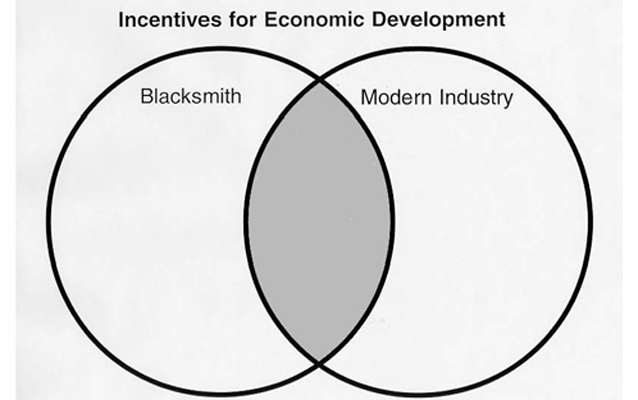Last updated: June 17, 2015
Lesson Plan
The Blacksmith in Society: Lesson 1- Economic Incentives for Industrial Development

- Grade Level:
- Middle School: Sixth Grade through Eighth Grade
- Subject:
- Social Studies
- Lesson Duration:
- 60 Minutes
- Common Core Standards:
- 6-8.RH.1, 6-8.RH.2, 6-8.RH.7, 6.RI.1, 7.RI.1, 8.RI.1
- State Standards:
- Maryland Learning Outcomes (MLO) 1.2, 2.2, 2.7, 3.3, 3.5, 3.6, 3.8, 4.7
- Thinking Skills:
- Remembering: Recalling or recognizing information ideas, and principles. Understanding: Understand the main idea of material heard, viewed, or read. Interpret or summarize the ideas in own words. Applying: Apply an abstract idea in a concrete situation to solve a problem or relate it to a prior experience. Analyzing: Break down a concept or idea into parts and show the relationships among the parts.
Objective
After comparing incentives offered to an 18th century blacksmith with incentives offered to modern corporations, students will understand how economic strategies are used to encourage industrial and community growth.
Background
The reading for Lesson Plan #1 indicates that blacksmiths were a vital part of early communities. At least one town offered property as an enticement, hoping to attract a skilled and able blacksmith. The conditions, as presented, tell us that a centrally located blacksmith shop was beneficial to the community and that community officials believed the blacksmith's services would be needed indefinitely. Striking similarities exist between the offer made by the town of Derby to John Smith, and economic incentives offered by communities to modern corporations. Students will have the opportunity to think about what they already know about colonial artisans, read the primary document and compare current events. This will show how some basic economic strategies have remained constant through the centuries.
Preparation
-
Copy of reading from The Blacksmith prepared as an overhead transparency or displayed in another form visible to all students.
-
Print articles discussing tax and other incentives offered by government entities in the hopes of attracting business to the local area (three are provided, but teachers can use any articles relevant to their area). Also cut out the different sections of the background reading and provide to students.
- Print copies of the Venn Diagram, Incentives for Economic Development.
Materials
The first party of settlers that came to Jamestown, Virginia, in 1607 included a blacksmith by the name of James Reed. By the end of the very next year another smith was needed, and in 1611, to meet the growing demand for iron workers, four more smiths were sent over by the London-based Virginia Company. New England towns also acknowledged the importance of this craftsman, as shown in the Derby, Connecticut, town records for 1711. This reading describes the benefits offered to a blacksmith.
Download Reading for lesson plan 1: Excerpt from The Blacksmith (p. 94)
Students will fill in this diagram to show what benefits or incentives were offered to blacksmiths and those that are currently offered to modern industry.
Download Venn Diagram: Incentives for Blacksmiths and Modern Industry
Teachers will search for articles related to tax or other incentives to bring businesses into specific communities or print out the PDF file of three articles provided. This will help students draw a modern parallel between the blacksmiths and practices that still occur today.
Download Tax Incentive Articles
Teachers can give students different pieces of this collection of background reading materials.
Download Background Reading on Blacksmiths
Lesson Hook/Preview
Ask students to independently read the excerpt (p. 94) from the Blacksmith and write a 2-3 sentences on whether they think this is a good opportunity for John Smith. Why or why not?
Procedure
-
Distribute contemporary tax incentives articles and background reading excerpts to students; try to locate multiple articles so that not all students read exactly the same material. Allow students time to read their materials.
-
Have an individual read the excerpt from The Blacksmith out loud to the class.
- Using the Venn Diagram included, instruct students to list the incentives offered to the blacksmith or to modern businesses in the appropriate circle. Incentives offered to both groups will be listed in the shaded area.When the list is complete, lead students in a discussion that compares the real economic value to the blacksmith or business and to the respective communities. For example:
• What is the true value of the land offered to the blacksmith in comparison with the land, tax incentives or other offers made to modern business?
• How will the community change or benefit from having a blacksmith or additional business come to the area?
• What happens if the individual or business does not meet the expectations of the community?
• What steps must be taken to alleviate the situation and find a suitable replacement?
Vocabulary
-
blacksmith: a person who makes horseshoes and shoes horses or a person who forges objects of iron.
-
industrial development: The sector of an economy made up of manufacturing enterprises
-
slavery: legal or economic system under which people are treated as property
4. economics: the science which studies human behavior as a relationship between given ends and scarce means which have alternative uses
Assessment Materials
Discussion or Writing Prompt: How does the situation with the blacksmith apply to businesses today? Do businesses always live up to expectations? Do incentives always work? What are the effects of businesses both coming and leaving communities based on incentives?
Additional Resources
NPS: Teaching with Historic Places
NPS: Camp Misty Mount: A Place for Regrowth
Lesson Plan Supplement 1: Additional Activities(PDF in google folder) and https://www.nps.gov/cato/forteachers/upload/lpsupp.pdf
Blacksmith in Society Site Bulletin (supplement 2) (PDF in google folder) and https://www.nps.gov/cato/forteachers/upload/bssiteb.pdf
Related Lessons or Education Materials
Five lesson plans are available for the Blacksmith in Society:
Lesson Plan 1: Economic Incentives for Industrial Development
Lesson Plan 2: Mapping Your Community
Lesson Plan 3: The Cost of Wages
Lesson Plan 4: The Price of Freedom
Lesson Plan 5: Revitalizing the Spirit
